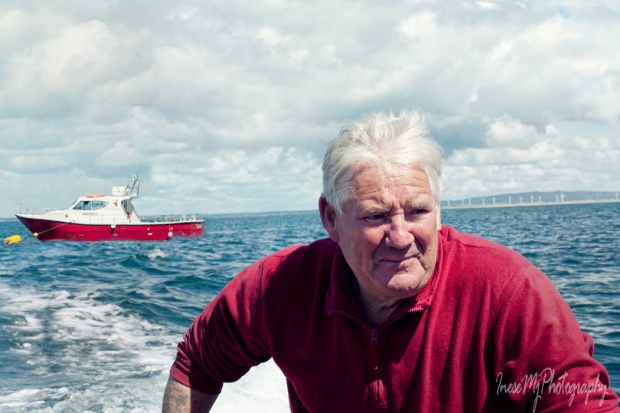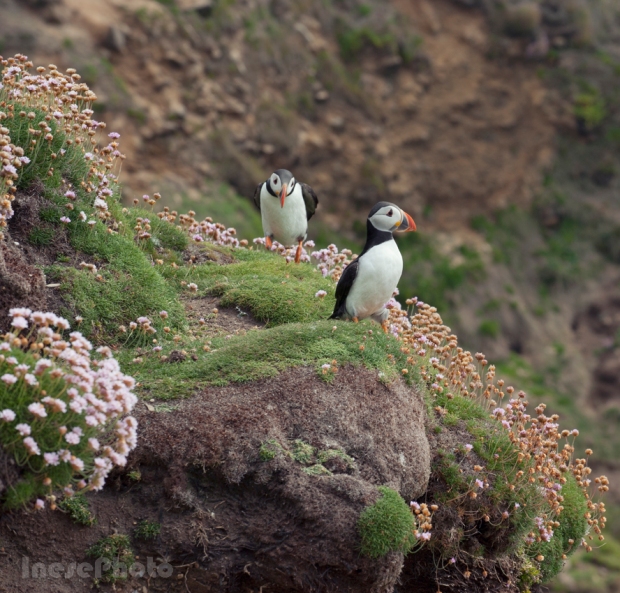As I do every summer, I went to the Great Saltee once again, this time in July. You can find some of my previous posts here, and learn more about the history, geography and wildlife of the island.
Thanks to the kind Captain Bates we got an extra hour on the island – a treat! Here is his An Foracha – A Guillemot – waiting for us to board.
Overcast at the start of my trip, the sky cleared by the time I climbed to the highest point of the island.

To get there, I had to walk through the shoulder-high ferns, full of wildlife. Thankfully, I travel light, and I actually enjoy the steep climb. People often ask me how long it takes to walk to the Gannet colony, and I can honestly say – it depends on how fast you walk. The distance is less than a mile.

I quickly walked through the Black-backed gull territory leaving them for later. First, I would go to visit the gannets.
It was so exciting to see the Gannet colony get larger and nest on the former path. I also noticed that the Shag dynasty who used to nest under the rocks for years and didn’t mind the visitors walk over their heads, abandoned their nesting territory. Later I spotted a Shag family on the side of the cliff, far from the path. Fledgling time?
I climbed down and camped behind the rock in the right side of the picture. The birds didn’t mind.
Nothing like clumsy, fluffy, sweet and defenseless chicks! How many of them have been snatched and eaten by gulls… They have nowhere to hide on this bare rock.
This is what I love most – the facial expression of a chick looking up at his mother.
Looks like this chick is asking for food. It is what they do – only look, never flap their wings or move about the nest. Now and again some of the gannets take off, and some land. The colony is always in motion. Gannets never fly with fish in their bill. They swallow the fish under water and feed their young regurgitated fish opening their mouths wide for the chicks to fetch the food – I have a picture in one of my blog posts.
Gannets look beautiful in flight, but landing is not their forte.
This poor devil crash-landed on a wrong nest.
This one landed smoothly and displayed a dance.
This gannet landed right in front of me. I think it is a female. After displaying some moves I could not interpret, the bird walked away and finally found her nest.
These gannets are grown up but they are not breeding this year for some reason.
I spent an hour alone with the gannets. Sadly, it was time to leave. I quickly took some in-flight pictures and a video to send to my grandchildren. Till we meet again, beautiful birds.
Great black-backed gull chicks are cute, but their growing numbers are worrying. These gulls are opportunistic feeders and predators who attack and kill other seabirds and juveniles.
There are chicks on the top of every rock. Look at these skinny legs!
I took these pictures from the path. Mama gull wouldn’t let me come any closer.
This one is a Herring gull’s son.
Guillemots, elegant birds who remind me of a whippet, have a baby too. This baby is almost a fledgling.
A younger and fluffier chick.
This Razorbill daddy made my day.
There was a chick somewhere under the rock, and the daddy was feeding him with the sand eels, one at a time.
The last sand eel.
Done with the feeding. What a good daddy!
Thank you for reading! I will share more pictures in two weeks.
 Have a wonderful weekend!
Have a wonderful weekend!



























































 Have a wonderful week!
Have a wonderful week!

















 Have a wonderful weekend!
Have a wonderful weekend!






























